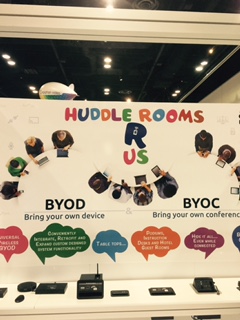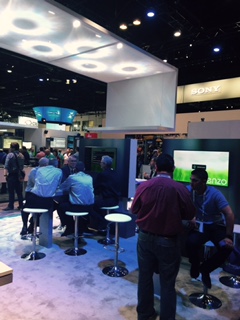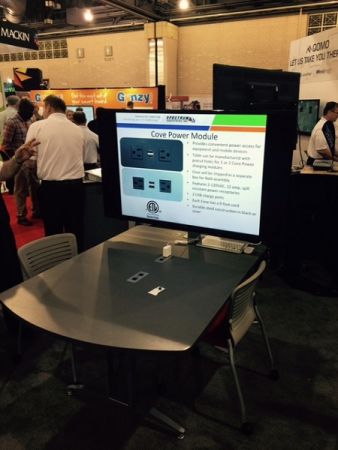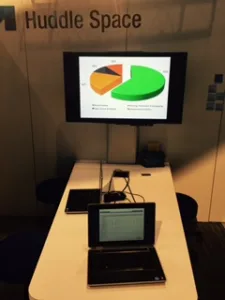One of the most pronounced developments appearing at InfoComm 2015 this year involved the stately arrival of the venerated “huddle space” in a featured posture in the exhibit hall. (I stopped counting at 12 huddle station solutions in the cavernous Orlando expo hall.)

The solid emergence of this meme met with perfect personal timing. This month, I have a meeting with a school architect, who asked to meet with me on the topic of new trends and developments in educational teaching spaces. His firm wants to stay current in the design of instructional spaces.
The venerated “huddle space”, with associated displays
 Huddle Rooms R US at InfoComm 2015
Huddle Rooms R US at InfoComm 2015
As stated previously, huddle space solutions were to be found in most rows and many exhibits throughout the InfoComm complex. Some had a corner showing their huddle space solutions; others proudly featured this layout in their booth, and still others divided their entire exhibit space into multiple huddle spaces (as opposed to auditorium, bench, bar, or walk-by tables). These latter exhibit spaces were quite effective, drawing many customers into seated, small-team discussions. Participants clearly appeared much more comfortable, drawn in, and communicative in these settings.
 An InfoComm booth made entirely from twelve huddle spaces
An InfoComm booth made entirely from twelve huddle spaces
Huddle Spaces in Education
The meme repeated itself at the ed-tech ISTE conference in Philadelphia, with huddle spaces also being featured, although more sparsely, in the exhibit hall. In fact, Panasonic offered one of the most delightful booths, entirely constructed of huddle spaces. It really worked for interfacing with educational customers. In fact, the experience was great.
 Huddle spaces at ISTE
Huddle spaces at ISTE
Another huddle space on display at ISTE in Philadelphia
 Panasonic’s booth was made entirely of huddle spaces. It worked!
Panasonic’s booth was made entirely of huddle spaces. It worked!
Although huddle spaces are not entirely new in education, the specific term “huddle space” is in fact relatively new. Instead, a babylon of other terms are used to describe this instructionally powerful seating configuration in education. Steelcase calls them active learning environments; Bretford calls them teaming tables; and Smith Systems call them media tables. And, depending on what their marketing genies have decided to use as the magic words, other firms and educational institutions also call them lounges, hublets, coves, team gardens, collaborative learning environments, informal learning environments, learning suites, or learnlabs. But they are all the same idea, and the idea is growing. Here are some interesting developments:
- Many universities, like the University of Wisconsin, are busy replacing computer labs with multiple huddle spaces;
- Many K12 schools and higher-ed institutions, like Emory University and NJIT, are installing huddle spaces throughout their buildings: in libraries, in classrooms, in common spaces, in dorms, and any place else they think fits
- A recent Steelcase whitepaper outlines the rationale for carving out such technology-enhanced workspaces
- This video goes a long way in showing how these spaces can operate
Implications for the Display Industry
The growth of this new huddle space meme in education settings has some noteworthy implications for firms selling display technologies to the education market:
- This new group-focused learning space requires connectivity, device agnostic solutions, and transparent operation
- The impact on display sales will be positive: schools will order more and larger displays to accommodate huddle space growth in libraries, conference rooms, classrooms, dorms, engineering and medical spaces, and large common spaces
- The impact on display sales will be negative: schools will order far less individual small displays when replacing an entire computer lab with huddle spaces
- The emergence of huddle spaces in education requires that manufacturers seek out new partners, new integrators, and new technologies that can support these emerging learning hubs
- Large displays, interactive displays, or projectors are certainly not out of the equation; these valuable learning technologies remain important and constant for full-group viewing and pull-together experiences
-Len Scrogan

